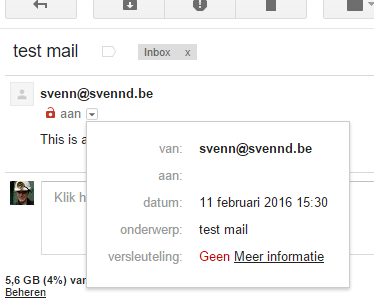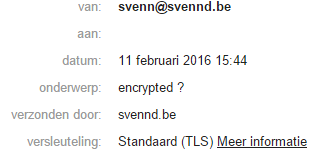Setting up Postfix TLS with Let’s Encrypt
Posted on February 12, 2016 • 3 minutes • 529 words • Suggest Changes
I’m not an expert in configuring mail servers. In fact I have never setup a dedicated mail server and there are no “simple”, complete, updated online tutorials. Most articles are ending with : if you don’t know how to do it, don’t touch it, cause you will be in blacklist/spam before you can say ‘Baboon bamboo’ five times.

They are most likely true, so I don’t want to have a mail server, but my server is sending mails isn’t it ? When people comment or respond I get mail and in return -I hope- when I respond people also get notified by this, through mail… this magically works and I believe its postfix’s doing. Now recently I get mails that are coming from a non encrypted mail server… bummer right ? Well Gmail, (Google, Alphabet) recently started marking these kind of mails with a red unlocked-lock, kinda the opposite of the green lock in-front of https. (see the url of svennd.be)
For example :

While this is nothing to worry about **yet **the fact that google wants us to start encrypting the connection between ‘mail’ servers, its only a matter of time before they will force you to encrypt this. I don’t think its that crazy, so I searched the web for a solution. I have found bits all over, but nothing straightforward, hence I will share my method, while my method might not be required or optimal, you get fancy nice encryption support on mail connections such as : (no green padlock sadly)

Changes to postfix/main.cf
The file you are looking for is _/etc/postfix/main.cf, _I changed quite some values, not all of them might be required.
These I entered / changed :
myhostname = svennd.be mydomain = svennd.be myorigin = $mydomain
I added these values :
# logging smtpd_tls_loglevel = 1 # Allow use of TLS but make it optional smtp_use_tls=yes # Disable SSLv2/3 as they are vulnerable smtpd_tls_protocols = !SSLv2, !SSLv3 smtp_tls_protocols = !SSLv2, !SSLv3 # Insist on stronger ciphers smtpd_tls_ciphers = high smtp_tls_ciphers = high # keys smtp_tls_cert_file = /etc/letsencrypt/live/svennd.be/fullchain.pem smtp_tls_key_file = /etc/letsencrypt/live/svennd.be/privkey.pem
In case you don’t have SSL yet, its free using Let’s Encrypt, and I even have a tutorial up here for Centos 6.X! Now SMTP is the tool that is used to send mails, SMTPD is the part to receive mails. So in my case I only need the SMTP configuration. After these changes you can restart the service :
service postfix restart
Now you might wanne test this, for this purpose you can just use sendmail which is included in Centos, and probably in most distro’s as part of postfix.
sendmail recipient@gmail.com From: myname@svennd.be Subject : test mail this is my test mail with no real content .
note : the single dot is “end of mail”; after that enter and wait a few seconds (its being send)
Conclusion
The next person who says mails are just text files send around… ow boy… anyways, setting up a mailserver remains a illusive part of the sysadmin task for me. However encrypting the server to server connection seems to work, thanks to the SSL certificates of Let’s Encrypt.
Reference
- Excellent read configuring postfix SMTP.

 Buy me a Dr Pepper
Buy me a Dr Pepper